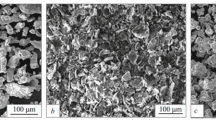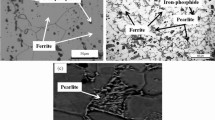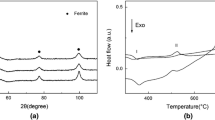Abstract
In sintered as well as cast steels presence of phosphorus is a problem as it induces brittleness in the steels and deteriorates the mechanical properties. The present research work describes a P/M route to produce ductile iron phosphorous alloys. Alloys with phosphorus contents 0, 0.35, 0.65, 1.3, 2, and 3 wt.% were developed by a powder forging route. Care was taken to ensure that no liquid-phase formation takes place during processing. First, a master alloy powder containing 5 wt.% phosphorus was produced by reacting water-atomized iron (Fe) powder with orthophosphoric acid. The iron phosphate (master alloy) particles were then blended with the iron powder. The blended powders were placed in a mild steel can and hot forged at 1323 K in a flowing hydrogen atmosphere. Hot-forged slabs were re-forged to final density and then homogenized at 1373 K for 2 h. Increasing the phosphorus content led to an increase in strength and hardness of forged alloys. Alloys with phosphorus contents < 1 wt.% exhibited significant ductility, suggesting that the presence of phosphorus did not cause the expected embrittlement. The solid-state processing used may lead to development of ductile phosphorus-containing alloys with attractive properties.










Similar content being viewed by others
References
R. Balasubramaniam, Alloy design of ductile phosphoric iron: ideas from archaeometallurgy. Bull. Mater. Sci. 26(5), 483–491 (2003)
K. Abiko, S. Suzuki, H. Kimura, Effect of carbon on the toughness and fracture mode of Fe–P alloys. Trans. Jpn. Inst. Metals 23(2), 43–52 (1982)
M. Paju, R. Moller, The effect of boron on phosphorus segregation in austenite. Scr. Metall. 18(8), 813–815 (1984)
R. Ding, A. Islam, S. Wu, J. Knott, Effect of phosphorus segregation on fracture properties of two quenched and tempered structural steels. Mater. Sci. Tech. 21(4), 467–475 (2005)
V.N. Zikeev, A.P. Gulyaev, V.A. Marchenko, Effect of phosphorus on the properties of structural steels. Metal Sci. Heat Treat. 15(11), 933–935 (1973)
V.N. Zikeev, Alloying and the structure of constructional steels resistant to hydrogen embrittlement. Metal Sci. Heat Treat. 24(5), 320–326 (1982)
C.L. Briant, Grain boundary segregation of phosphorus in 304L stainless steel. Metall. Trans. A 16(11), 2061–2062 (1985)
K.H. Moyer, Magnetic materials and properties for part applications. ASM Hand Book Powder Metall. Appl. 7, 1006–1019 (1998)
J.A. Bas, J.A. Calero, M.J. Dougan, Sintered soft magnetic materials. Properties and applications. J. Magn. Magn. Mater. 254, 391–398 (2003)
B. Węgliński, J. Kaczmar, Effect of Fe3P addition on magnetic properties and structure of sintered iron. Powder Metall. 23(4), 210–216 (1980)
R. Balasubramaniam, On the corrosion resistance of the Delhi iron pillar. Corros. Sci. 42(12), 2103–2129 (2000)
R. Balasubramaniam, Iron pillar. Current Sci. 85(3), 378-382 (2003)
G. Straffelini, V. Fontanari, A. Molinari, B. Tesi, Tensile and fatigue behavior of phosphorus alloyed sintered steels. Powder Metall. 36, 135 (1993)
J.W. Stewart, J.A. Charles, E.R. Wallach, Iron–phosphorus-carbon system: part 1–Mechanical properties of low carbon iron–phosphorus alloys. Mater. Sci. Tech. 16(3), 275–282 (2000)
H.G. Rutz, F.G. Hanejko, High density processing of high-performance ferrous materials, in International Conference and Exhibition on Powder Metallurgy and Particulate Materials, Toronto, Canada, (1994)
P. Skoglund, M. Kejzelman, I. Hauer, High-density P/M components by high-velocity compaction. Adv. Powder Metall. Part. Mater. 4, 4–85 (2002)
E. Klar, P.K. Samal, Powder Metallurgy Stainless Steels: Processing, Microstructures, and Properties (ASM International, Materials Park, 2007)
B.E. Hopkins, H.R. Tipler, The effect of phosphorus on the tensile and notch-impact properties of high-purity iron and iron-carbon alloys. J. Iron Steel Inst. 193, 218–237 (1958)
R. Kirchheim, Grain coarsening inhibited by solute segregation. Acta Mater. 50(2), 413–419 (2002)
M.A. Islam, N. Sato, Y. Tomota, Tensile and plane bending fatigue properties of pure iron and iron-phosphorus alloys at room temperature in the air. Trans. Indian Inst. Met. 64(3), 315–320 (2011)
E. Klar, M. Svilar, D.F. Berry, Infiltrated powder metal part having improved impact strength tensile strength and dimensional control and method for making same. United States patent US 4, 861, 373 (1989)
F.J. Panetoa, J.L. Pereiraa, J.O. Limaa, E.J. Jesusa, L.A. Silvaa, E. Sousa Limab, R.F. Cabrala, C. Santos, Effect of porosity on hardness of Al2O3–Y3Al5O12 ceramic composite. Int. J. Refract. Metals Hard Mater. 48, 365–368 (2015)
W. F. Jandeska, Strength and ductility enhancement of low temperature sintered iron powder structures. SAE Technical Paper No. 820231 (1982)
T.S. Eyre, Wear mechanisms. Powder Metall. 24(2), 57–63 (1981)
R.V. Batienkov, V.Y. Dorofeev, Z.V. Eremeeva, V.V. Artemov, Preparation of wear-resistant powder materials based on iron by hot stamping in the presence of a liquid phase. Metallurgist 55(3–4), 289 (2011)
W.B. James, M.J. McDermott, A. Robert Powell, Powder forging. ASM Hand Book Form. Forg. 14, 188 (1998)
S.V. Muchnik, Phosphorus-containing sintered alloys (review), Inst. Mater. Sci. translated from poroshkovaya Metallurgiya 12(264), 20–27(1984)
P. Lejcek, Grain Boundary Segregation in Metals, vol. 136 (Springer Science & Business Media, Berlin, 2010)
M. Wettlaufer, R. Kaspar, Effect of phosphorus on the ductility of high strength spring steels. Steel Res. Int. 71(9), 357–361 (2000)
X. Song, Z. Yuan, J. Jia, D. Wang, P. Li, Z. Deng, Effect of phosphorus grain boundaries segregation and precipitations on mechanical properties for Ti-IF steel after recrystallization annealing. J. Mater. Sci. Technol. 26(9), 793–797 (2010)
P. Lindskog, The effect of phosphorus additions on the tensile, fatigue, and impact strength of sintered steels based on sponge iron powder and high-purity atomized iron powder. Powder Metall. 16(32), 374–386 (1973)
P. Lindskog, J. Tengzelius, S. Kvist, Phosphorus as an alloying element in Ferrous P/M. Mod. Dev. Powder Metall. 10, 97–127 (1977)
S.K. Chaurasia, U. Prakash, P.S. Misra, K. Chandra, Development of P/M Fe–P soft magnetic materials. Bull. Mater. Sci. 35, 191 (2012)
S.K. Chaurasia, U. Prakash, K. Chandra, P.S. Misra, Comparisons of sintered technology with powder forging for Fe–P soft magnetic alloys. Mater. Sci. Forum 710, 297 (2012)
Acknowledgments
This work was carried out in the Department of Metallurgical and Materials Engineering, IIT Roorkee. MJP Rohilkhand University, Bareilly (UP), India, sponsored one of the authors (S. K. Chaurasia).
Author information
Authors and Affiliations
Corresponding author
Rights and permissions
About this article
Cite this article
Chaurasia, S.K., Prakash, U. & Dabhade, V. Effect of Phosphorus on Microstructure and Mechanical Properties of Iron-Based Alloys Processed Through Powder Forging. Metallogr. Microstruct. Anal. 6, 561–568 (2017). https://doi.org/10.1007/s13632-017-0406-1
Received:
Revised:
Accepted:
Published:
Issue Date:
DOI: https://doi.org/10.1007/s13632-017-0406-1




